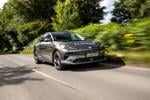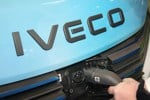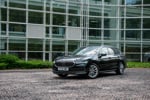So let’s raise a glass to Jeep, which has just launched its first LCV in Britain in the shape of the Pioneer, a Cherokee with the rear seats removed and a loadbed added.
The Jeep name is legendary – so famous in fact that I don’t need to go into its history. Suffice to say that the manufacturer’s slogan with this model is ‘ruggedness, capability and refinement’ – and it’s a promise that is fulfilled.
While the Pioneer won’t attract hordes of big fleet buyers, it should appeal to either firms which need a van with an off-road capability or those which want to portray a particular image.
Imagine one of these vehicles sashaying down a city street complete with trendy signage. It will speak volumes about the company it represents.
Weighing in at £17,503 ex-VAT and boasting a host of standard goodies such as multi-stage airbags, headlamp levelling, ABS brakes, air conditioning and a CD player, the Pioneer means business right from the start. Compare the prices of the Mitsubishi Shogun 3.2 DI-D swb at £17,996 and the Land-Rover Discovery Commercial at £19,397 and you’ll see what I mean.
And the Pioneer is no slouch on the road. Powered by a 2.5-litre common rail turbodiesel unit offering 145bhp and 251lb-ft of torque, it will reach 60mph from standing in 13.5 seconds and has a top speed of 101mph.
Methinks the Pioneer will shake up the sector in no uncertain terms.
Outside
 You’ll see this van coming and recognise it instantly. It has the usual seven slot Jeep grille at the front and looks like a sizeable barn door coming towards you.
The whole vehicle is swathed in black plastic protectors which not only make it look incredibly macho but will protect it from the annoying scratches and knocks that seem to plague vans. Our test vehicle had optional metallic paint at £210 and alloy wheels at £320. And before penny-pinching fleet managers scoff at such unnecessary extras, let me tell you that at selling time, a van with these additions could well be worth more than their cost new. The roof features attractive black rails and the side windows are body-coloured, leaving plenty of room for stylish decals and signs.
In the front
Entry is by remote plip lock and the doors open to reveal a massively chunky cab which feels like it might have been hewn from a single piece of rock.
The first surprise is that the seats are beautifully moulded to the body, provide plenty of side support and are incredibly comfortable. Most American vehicles have horrible wide flat squashy seats to cope with those ample American backsides, but the Pioneer seems to have been built with more diminutive European posteriors in mind.
All the knobs and switches are good and chunky and there are big grab handles on both sides for when the going gets rough.
Windows are powered and the CD player proves to be a good quality.
One drawback of making a van from a car is that storage spaces tend to be few and far between. There is a small glovebox (why on earth do we call them gloveboxes?) and minute document holders in the doors but apart from a centre console which features eight CD slots and two cupholders, that’s about your lot. No room for white van man’s precious two-litre cola bottle and nowhere for his snap tin either. Ah well, you can’t have everything.
In the back
If the front doors are chunky, the rear tailgate seems like something you might stumble across at Fort Knox. And there is no need to lift the upper window glass first either. As soon as you yank on the bottom door, the glass slides open automatically on a damper system and tucks itself up out of the way. Nice touch.
The rear pair of doors open too, although they will only allow you to load up small items.
Once opened, the load area is good and square and offers 1.9 cubic metres of space, against the Discovery’s 3.0 cubic metres and the Shogun’s 2.0 cubic metres, with a payload of 359kg, against the Shogun’s 500kg and the Discovery’s 680kg.
Our test van came with the optional steel bulkhead at £200 and the whole load area is covered in either plastic or carpeting right up to the roof, which gives the vehicle much more of an upmarket feel than your average van.
There are six load-lashing eyes, although they don’t fold into the floor, so could catch on loads when they are being slid in or out.
Load length is 1.2 metres, width is 1.2 metres and height is 1.0 metre. Braked trailer towing weight is 2,688kg.
On the road
The big diesel powerplant starts up in the morning with a mighty meaty roar, although because it is a common rail engine, it lacks the old-fashioned rattling and shaking.
Changing from two-wheel drive to four-wheel drive high and low ratios is done by a rather puny looking lever that resembles a small handbrake. But to make up for it, the gear lever is a massive affair that resembles a tree trunk. I feared at first that changing gear might be a clunky affair but the stick proved easy to use and slick, despite its size.
At motorway speeds, the engine settles down to a thrum and there is a total lack of squeaks, shakes and rattles. The net result
is that long journeys can be accomplished with no aches and pains.
Average fuel consumption should reach 31.4mpg, which I suppose isn’t bad for a vehicle of this size.
A full load and an enthusiastic driver could of course make quite a difference to this figure. It’s nice to see that ABS brakes are standard too.
Verdict
Give your drivers this vehicle and they’ll love you to bits. It’s chunky, stylish and incredibly good to drive. And the final clincher in the equation is that it is a very reasonable price.
Gross vehicle weight (kg): 2,520
You’ll see this van coming and recognise it instantly. It has the usual seven slot Jeep grille at the front and looks like a sizeable barn door coming towards you.
The whole vehicle is swathed in black plastic protectors which not only make it look incredibly macho but will protect it from the annoying scratches and knocks that seem to plague vans. Our test vehicle had optional metallic paint at £210 and alloy wheels at £320. And before penny-pinching fleet managers scoff at such unnecessary extras, let me tell you that at selling time, a van with these additions could well be worth more than their cost new. The roof features attractive black rails and the side windows are body-coloured, leaving plenty of room for stylish decals and signs.
In the front
Entry is by remote plip lock and the doors open to reveal a massively chunky cab which feels like it might have been hewn from a single piece of rock.
The first surprise is that the seats are beautifully moulded to the body, provide plenty of side support and are incredibly comfortable. Most American vehicles have horrible wide flat squashy seats to cope with those ample American backsides, but the Pioneer seems to have been built with more diminutive European posteriors in mind.
All the knobs and switches are good and chunky and there are big grab handles on both sides for when the going gets rough.
Windows are powered and the CD player proves to be a good quality.
One drawback of making a van from a car is that storage spaces tend to be few and far between. There is a small glovebox (why on earth do we call them gloveboxes?) and minute document holders in the doors but apart from a centre console which features eight CD slots and two cupholders, that’s about your lot. No room for white van man’s precious two-litre cola bottle and nowhere for his snap tin either. Ah well, you can’t have everything.
In the back
If the front doors are chunky, the rear tailgate seems like something you might stumble across at Fort Knox. And there is no need to lift the upper window glass first either. As soon as you yank on the bottom door, the glass slides open automatically on a damper system and tucks itself up out of the way. Nice touch.
The rear pair of doors open too, although they will only allow you to load up small items.
Once opened, the load area is good and square and offers 1.9 cubic metres of space, against the Discovery’s 3.0 cubic metres and the Shogun’s 2.0 cubic metres, with a payload of 359kg, against the Shogun’s 500kg and the Discovery’s 680kg.
Our test van came with the optional steel bulkhead at £200 and the whole load area is covered in either plastic or carpeting right up to the roof, which gives the vehicle much more of an upmarket feel than your average van.
There are six load-lashing eyes, although they don’t fold into the floor, so could catch on loads when they are being slid in or out.
Load length is 1.2 metres, width is 1.2 metres and height is 1.0 metre. Braked trailer towing weight is 2,688kg.
On the road
The big diesel powerplant starts up in the morning with a mighty meaty roar, although because it is a common rail engine, it lacks the old-fashioned rattling and shaking.
Changing from two-wheel drive to four-wheel drive high and low ratios is done by a rather puny looking lever that resembles a small handbrake. But to make up for it, the gear lever is a massive affair that resembles a tree trunk. I feared at first that changing gear might be a clunky affair but the stick proved easy to use and slick, despite its size.
At motorway speeds, the engine settles down to a thrum and there is a total lack of squeaks, shakes and rattles. The net result
is that long journeys can be accomplished with no aches and pains.
Average fuel consumption should reach 31.4mpg, which I suppose isn’t bad for a vehicle of this size.
A full load and an enthusiastic driver could of course make quite a difference to this figure. It’s nice to see that ABS brakes are standard too.
Verdict
Give your drivers this vehicle and they’ll love you to bits. It’s chunky, stylish and incredibly good to drive. And the final clincher in the equation is that it is a very reasonable price.
Gross vehicle weight (kg): 2,520
Payload (kg): 359
Load length (mm): 1,200
Load width (mm): 1,200
Load height (mm): 1,000
Max power (bhp/rpm): 141/4,000
Max torque (lb-ft/rpm): 251/2,000
Prices (excluding VAT): £17,503
 You’ll see this van coming and recognise it instantly. It has the usual seven slot Jeep grille at the front and looks like a sizeable barn door coming towards you.
The whole vehicle is swathed in black plastic protectors which not only make it look incredibly macho but will protect it from the annoying scratches and knocks that seem to plague vans. Our test vehicle had optional metallic paint at £210 and alloy wheels at £320. And before penny-pinching fleet managers scoff at such unnecessary extras, let me tell you that at selling time, a van with these additions could well be worth more than their cost new. The roof features attractive black rails and the side windows are body-coloured, leaving plenty of room for stylish decals and signs.
In the front
Entry is by remote plip lock and the doors open to reveal a massively chunky cab which feels like it might have been hewn from a single piece of rock.
The first surprise is that the seats are beautifully moulded to the body, provide plenty of side support and are incredibly comfortable. Most American vehicles have horrible wide flat squashy seats to cope with those ample American backsides, but the Pioneer seems to have been built with more diminutive European posteriors in mind.
All the knobs and switches are good and chunky and there are big grab handles on both sides for when the going gets rough.
Windows are powered and the CD player proves to be a good quality.
One drawback of making a van from a car is that storage spaces tend to be few and far between. There is a small glovebox (why on earth do we call them gloveboxes?) and minute document holders in the doors but apart from a centre console which features eight CD slots and two cupholders, that’s about your lot. No room for white van man’s precious two-litre cola bottle and nowhere for his snap tin either. Ah well, you can’t have everything.
In the back
If the front doors are chunky, the rear tailgate seems like something you might stumble across at Fort Knox. And there is no need to lift the upper window glass first either. As soon as you yank on the bottom door, the glass slides open automatically on a damper system and tucks itself up out of the way. Nice touch.
The rear pair of doors open too, although they will only allow you to load up small items.
Once opened, the load area is good and square and offers 1.9 cubic metres of space, against the Discovery’s 3.0 cubic metres and the Shogun’s 2.0 cubic metres, with a payload of 359kg, against the Shogun’s 500kg and the Discovery’s 680kg.
Our test van came with the optional steel bulkhead at £200 and the whole load area is covered in either plastic or carpeting right up to the roof, which gives the vehicle much more of an upmarket feel than your average van.
There are six load-lashing eyes, although they don’t fold into the floor, so could catch on loads when they are being slid in or out.
Load length is 1.2 metres, width is 1.2 metres and height is 1.0 metre. Braked trailer towing weight is 2,688kg.
On the road
The big diesel powerplant starts up in the morning with a mighty meaty roar, although because it is a common rail engine, it lacks the old-fashioned rattling and shaking.
Changing from two-wheel drive to four-wheel drive high and low ratios is done by a rather puny looking lever that resembles a small handbrake. But to make up for it, the gear lever is a massive affair that resembles a tree trunk. I feared at first that changing gear might be a clunky affair but the stick proved easy to use and slick, despite its size.
At motorway speeds, the engine settles down to a thrum and there is a total lack of squeaks, shakes and rattles. The net result
is that long journeys can be accomplished with no aches and pains.
Average fuel consumption should reach 31.4mpg, which I suppose isn’t bad for a vehicle of this size.
A full load and an enthusiastic driver could of course make quite a difference to this figure. It’s nice to see that ABS brakes are standard too.
Verdict
Give your drivers this vehicle and they’ll love you to bits. It’s chunky, stylish and incredibly good to drive. And the final clincher in the equation is that it is a very reasonable price.
Gross vehicle weight (kg): 2,520
You’ll see this van coming and recognise it instantly. It has the usual seven slot Jeep grille at the front and looks like a sizeable barn door coming towards you.
The whole vehicle is swathed in black plastic protectors which not only make it look incredibly macho but will protect it from the annoying scratches and knocks that seem to plague vans. Our test vehicle had optional metallic paint at £210 and alloy wheels at £320. And before penny-pinching fleet managers scoff at such unnecessary extras, let me tell you that at selling time, a van with these additions could well be worth more than their cost new. The roof features attractive black rails and the side windows are body-coloured, leaving plenty of room for stylish decals and signs.
In the front
Entry is by remote plip lock and the doors open to reveal a massively chunky cab which feels like it might have been hewn from a single piece of rock.
The first surprise is that the seats are beautifully moulded to the body, provide plenty of side support and are incredibly comfortable. Most American vehicles have horrible wide flat squashy seats to cope with those ample American backsides, but the Pioneer seems to have been built with more diminutive European posteriors in mind.
All the knobs and switches are good and chunky and there are big grab handles on both sides for when the going gets rough.
Windows are powered and the CD player proves to be a good quality.
One drawback of making a van from a car is that storage spaces tend to be few and far between. There is a small glovebox (why on earth do we call them gloveboxes?) and minute document holders in the doors but apart from a centre console which features eight CD slots and two cupholders, that’s about your lot. No room for white van man’s precious two-litre cola bottle and nowhere for his snap tin either. Ah well, you can’t have everything.
In the back
If the front doors are chunky, the rear tailgate seems like something you might stumble across at Fort Knox. And there is no need to lift the upper window glass first either. As soon as you yank on the bottom door, the glass slides open automatically on a damper system and tucks itself up out of the way. Nice touch.
The rear pair of doors open too, although they will only allow you to load up small items.
Once opened, the load area is good and square and offers 1.9 cubic metres of space, against the Discovery’s 3.0 cubic metres and the Shogun’s 2.0 cubic metres, with a payload of 359kg, against the Shogun’s 500kg and the Discovery’s 680kg.
Our test van came with the optional steel bulkhead at £200 and the whole load area is covered in either plastic or carpeting right up to the roof, which gives the vehicle much more of an upmarket feel than your average van.
There are six load-lashing eyes, although they don’t fold into the floor, so could catch on loads when they are being slid in or out.
Load length is 1.2 metres, width is 1.2 metres and height is 1.0 metre. Braked trailer towing weight is 2,688kg.
On the road
The big diesel powerplant starts up in the morning with a mighty meaty roar, although because it is a common rail engine, it lacks the old-fashioned rattling and shaking.
Changing from two-wheel drive to four-wheel drive high and low ratios is done by a rather puny looking lever that resembles a small handbrake. But to make up for it, the gear lever is a massive affair that resembles a tree trunk. I feared at first that changing gear might be a clunky affair but the stick proved easy to use and slick, despite its size.
At motorway speeds, the engine settles down to a thrum and there is a total lack of squeaks, shakes and rattles. The net result
is that long journeys can be accomplished with no aches and pains.
Average fuel consumption should reach 31.4mpg, which I suppose isn’t bad for a vehicle of this size.
A full load and an enthusiastic driver could of course make quite a difference to this figure. It’s nice to see that ABS brakes are standard too.
Verdict
Give your drivers this vehicle and they’ll love you to bits. It’s chunky, stylish and incredibly good to drive. And the final clincher in the equation is that it is a very reasonable price.
Gross vehicle weight (kg): 2,520 Payload (kg): 359
Load length (mm): 1,200
Load width (mm): 1,200
Load height (mm): 1,000
Max power (bhp/rpm): 141/4,000
Max torque (lb-ft/rpm): 251/2,000
Prices (excluding VAT): £17,503













Login to comment
Comments
No comments have been made yet.